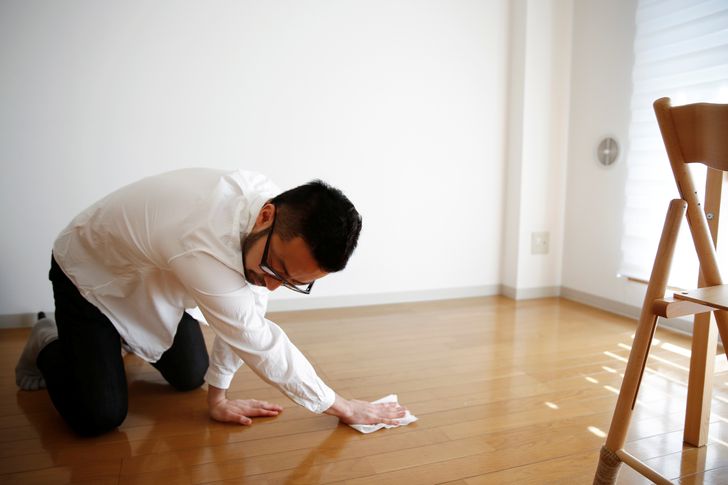
May 3, 2021
12 Weird Cleaning Techniques: Beer, Messies Anonymous and more
A difficult feeling rolls over when you see search queries like “clean the apartment.” Of course, it is correct to say “clean up”. But if you think about it, this popular search is extremely honest: the passive voice suggests that someone did this work without your participation. It is no coincidence that one of the most popular searches in the search: “how to clean the house with pleasure.” No one wants to clean – everyone dreams that the dishes are washed, the linen ironed, and the housekeeper came to clean the apartment.
I am deeply convinced that you can only get out of the apartment with pleasure – while someone else is cleaning it up. But there are people in the world who say: you can do the cleaning with a smile. Who are these superheroes?
1. Leo Babauta’s cleaning method: take away what you can hug
Creator of the minimalism and productivity blog zenhabits.net. Leo Babauta lives in San Francisco, enjoys self-discovery and running, writes books, and raises six children. Most of the blogger’s thoughts are about putting things in order. In particular, Leo recommends tidying up on the go: ate – washed a plate, saw dirt – swept, etc. In such a system, cleaning becomes a matter that you don’t notice. Babauta believes that it is necessary to do less in order not to do unnecessary work. For example, to put things in order not in the whole room, but in the territory that you can hug, wrap your arms around. And so to move – from point to point, spending 10 minutes on each.

When parsing the trash, Leo suggests sorting all things into three heaps: “leave”, “throw out” and “maybe”. It is forbidden to think for a long time. Things in a pile “maybe” are put into a closed box for six months. If you have not used them, the box is thrown away. The blogger allocates one evening for the analysis of each cabinet.
Half of the cabinet should remain unoccupied, then it is easier to keep it clean. The blogger also advises leaving gaps between things and grouping them by color – this makes the space seem less cluttered. Leo recommends treating cleaning as a liberation, smiling and breathing evenly – then the process will be a joy. The main thing is not to fall asleep.
Read also: Spring Cleaning: How to put things in order in your life
2. Flylady: take away the elephant piece by piece
One of the first who tried to get pleasure from cleaning was The Flylady system. This system was invented by American housewife Marla Scilly in 1999. Today, the reactive community consists of about a million people. Marla’s main suggestion was to forget the Saturday-eating nightmare of the weekly cleaning. Instead, the American offered to devote only 15 minutes to house cleaning every weekday and leave the weekend for herself. To do everything, you need to act as quickly as possible. To do this, a timer is started: if it rang, we stop work.

During the week, cleaning is done only in one of five zones in a clear sequence: entrance and dining room, kitchen/laundry/storage room, bathroom/nursery/workshop, bedroom/bathroom/toilet, and living room. In addition, there are obligatory “routines” and five minutes for parsing “hot spots” – hot spots where a mess starts in a particular room (shelves, boxes, etc.). It’s important to schedule an hour of weekly cleaning – the Hour of Blessing at Home. At this time, for example, all floors should be vacuumed. There are other techniques – you can get acquainted with them on the website of the movement.
Flylady has a particularly reverent feeling for a sink – it must always be perfectly clean. Among other principles, some are good for any person to take note of. For example, not letting yourself sit at the computer, not doing two things at the same time, and remembering to laugh.
Tip: The mechanical timer, thanks to the rhythmic ticking stimulates you to work better than the electronic one.
3. The House Burning Method: What Can You Take?
Alison Hodgson, the author of a series of materials on the “clutter” of consciousness, published on the American Houzz, also adheres to minimalist principles. In 2010, her family’s house burned down. The couple managed to push the children out into the street, and only a camera and a laptop were saved from their belongings. Clothes, diaries, books, children’s drawings, memorable trinkets, and numerous boxes of toys were burnt – in general, everything that occupied the corners, but was considered invaluable. This story prompted Alison to reconsider her views on the organization of space. “Ask yourself what you’ll grab in the fire,” is one of the exercises that Alison suggests doing to everyone busy sorting out the trash. Leave what you love, but what does not prevent you from maintaining cleanliness and order. This practice works especially well immediately after a vacation. First, the picture before the eyes changes, and hot spots are immediately visible. Secondly, breaking away from the usual way of life, we lose attachment to many things. There are a couple of days until it returns.
Read also: Cleaning Glass Shower Doors With Vinegar & Dawn
4. Course on decluttering
Decluttering is a craze for American housewives. This is not only a science to get rid of unnecessary things, but also a set of principles that prevent space from being overgrown with new rubbish. Allegedly, cleaning without it is a pleasure.
The essence of the method is to unload the space to a state that does not require much effort when cleaning. Fewer things mean less dust and more air. Some people start a special box for items they don’t use – and once a month they distribute or throw out the contents. Others get rid of one thing every 10 days. Still, others set aside 10-15 minutes a day for decluttering the apartment.
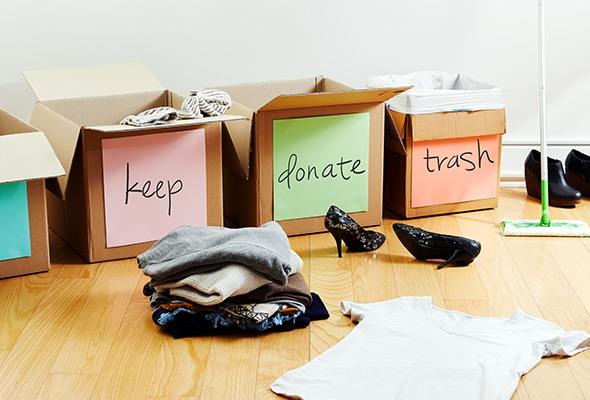
The main rule of decluttering is not to hesitate or give things a second chance. If you don’t wear a jacket, don’t fit in a dress – give it back. Throw out what needs repair and has not been repaired within a month. What is “suddenly needed someday” will never be needed.
Fact: Littering is an important element of all popular household systems. Every cleaning in the area according to the Flylady method begins with it. The technique “27 throws” is also used there: in 15 minutes you need to collect 27 items of any kind in the box to throw them away. In the “Kaizen” system, colored stickers are first glued to things according to categories from “need” to “throw away”.
Read also: Express cleaning if your parents/friends are coming soon
5. KonMari: leave only what you love
In popularity, Flylady is rapidly catching up with the KonMari system. It was invented by the Japanese woman Marie Kondo, the author of the book “Magic Cleaning” and three other best-selling books about organizing home life. Marie is sure that proper cleaning has a tremendous therapeutic effect: with its help, you can put not only things in order but also your thoughts.
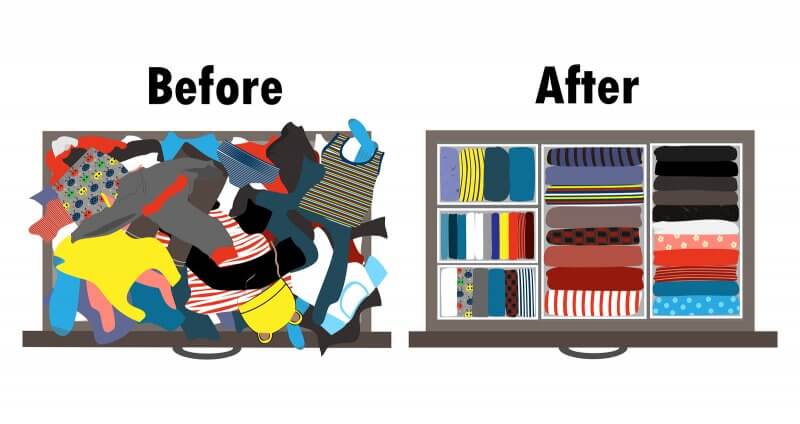
Every object in the apartment affects the mood of the tenants. The task of the owners is to leave only things that carry positive energy. One of KonMari’s rules: when sorting out the clutter, take a thing in your hands and ask yourself if it causes joy (“do I love it?”). If not, throw it out after thanking it. Dialogue with things – a Japanese tradition – is the basis of the Mari Kondo cleaning technique.
In addition, Marie suggests cleaning not by zone, but by category: clothes, books, documents, etc. First, all things in each category are collected from all rooms into one pile. This gives an idea of the scale of the disaster. Then the unnecessary ones are sifted out. A person conducts selection alone, without consulting anyone.
All things of one function should be stored in one place. The KonMari Method of cleaning promotes vertical storage, not only for documents and books but also for clothing. It is folded into neat rectangles or rolled like sushi. She suggests hanging things from dark and warm to light and bright. Disliked clothes are prohibited from being transferred to home clothes.
Read also: 17 Important Steps To Do When Moving Into a New Home
6. Japanese way: one person – one cover
Japanese blogger Fumio Sasaki is an ardent adherent of minimalism and the author of the popular book We Don’t Need Things Any More. He is sure that the habit of carrying everything into the house is the habit of previous generations, who were stunned by material abundance. It only hinders the modern person to be liberated. Fumio offers a radical way to tidy up your apartment: just don’t buy things that you don’t need to buy.

The blogger’s life is extremely ascetic. According to him, if there is an earthquake, he can easily leave the house with all his belongings, since they are placed in a small case. This theory – “have as much as you can take” – is popular in the West as well. For some reason, the number 15 is significant – this is how many things a person should have, and no more.
Read also: Simple Steps on How to Vacuum Your Carpet
7. The three-circle method …
An interesting way to organize cleaning “for the lazy” can be found on the Internet. All that is known about its author is that this is “a woman whose strength is limited for health reasons.” First, all cases are entered into three to-do lists or circles. In a small circle, there are obligatory daily tasks (up to 10), on average – obligatory weekly (up to 21), in a large circle – all the rest (up to 60). When all the tasks from the small circle assigned for today have been completed, you can move on to the middle one and then to the large one. If you didn’t have time with the second and third laps – it’s okay. The next day, start again with “small” things, and then move down the list of “medium”. That is if you didn’t have time to wash your bathtub yesterday, do it today. With this approach, you always do the necessary minimum, and the rest of the cases – according to the circumstances.
Read also: Why You Should Divide Cleaning Into Daily, Weekly, and Monthly
8. … and other borrowings from time management
The same technology is used by Mark Forster’s “Autofocus”. A time management specialist suggests that you write down all the things in one notebook and do them, choosing those that you like at the moment. If you don’t like anything on the page – go to the next one. Completed things should be deleted.
Another popular time management tip is to start cleaning tricky and unpleasant areas while you are full of energy. Usually, it is a toilet, bathroom, and kitchen. The stronger the fatigue, the less efficiency, and the more irritation. Do not be distracted from the task at hand. Wipe dust off cabinets – do not turn your attention to sorting things out. Dust first, then move to things. Otherwise, you will get tired without completing a single case.
Tip: Do the cleaning from top to bottom and from left to right – this way you save yourself unnecessary work.
9. “Sparkling House”: cleaning in real-time
Casablitzblanka or “Sparkling House” is a German method of effective cleaning. Its main principle is “destroy the evidence”. If the floor is dirty – run for a broom, if the stove gets dirty – wash it right there, don’t save up dirty dishes, put things in the closet right away. Tidying up in real-time saves a lot more time down the road. The Germans suggest not to make indulgences even for children.

Cleaning according to the “Sparkling House” system, like Flylady’s, has its own routine: five minutes in each room in the morning and in the evening. This is not all. While Flyladys are cleaning by zones, then there is a room of the day for which 30 minutes are devoted. There are also additional tasks by category: “sheep” – for the room of the day, “ducks” – tasks for sorting out trash, “worms” – tasks for children. Sheep should be done one by one, ducks – several at once.
Read also: 27 Tips: Post Construction Cleaning Checklist
10. “Messies anonymous”: put the thing back in place
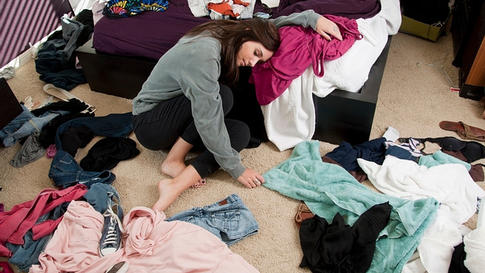
Its author, American Sandra Felton, put up with her disorganization in everyday life for a long time until she lost her dissertation in the mess. The analytical mind helped to come up with a system in which you can maintain cleanliness effortlessly. The basic principle is to find the right place for each item and always return it there. And not someday, but immediately. Anyway, any business that takes less than 30 seconds should be done without delay. It seems to be a simple principle, but it takes not a single month to develop a habit. But then the time for general cleaning is reduced significantly.
There are three decluttering methods in the system: Mount Vermont, Vesuvius, and Rushmore. The first one resembles Leo Babauta’s method – you need to take three boxes (“leave”, “throw out” and “think about”) and sort all the things in the apartment into them. With these boxes, “Messies anonymous” go around the whole apartment. Vesuvius is all the same, but for a limited time. “Rushmore” involves the division of responsibilities into several family members. The system is not limited to decluttering, it has its cleaning calendar. And most importantly, an active support group, which you can turn to at any time for advice and sympathy. Therefore, lazy and anonymous, as the well-known community of alcoholics.
Read also: How easy it is to keep your home clean and tidy
11. “Seirisaton”: cleaning according to the psycho-type
This cleaning system was described by Yukiko Kaneko in Life Without Things: How to Free Your Home and Heart. Its trick is in the psychological approach. Before getting down to cleaning, the author offers to understand the reasons for the mess. She identifies six psycho-types of owners: “housekeeping mommy”, “too busy”, “too tired”, “stingy grandmother”, “too many hobbies”, “shopping queen”. Each psycho-type has its problems and its way of life. Therefore, according to Yukiko, general recommendations do not work well here. The author draws attention to the pain points of each psycho type. For example, household mothers are advised to leave a fifth of any drawer or shelf free. Too busy people need to pay attention to the hallway, work desk, and other hotspots. Shopping queens need outside help to sort things. And the tired ones are generally advised to forget about cleaning until they get enough sleep and “work up” the norm.
Read also: How To Clean and Disinfect Your house During the Spread of Coronavirus
12. Beer cleaning
The cleaning method described by Nancy Mitchell is one of the most controversial in terms of health care. But enough with moralizing.
Nancy has always hated stroking. She was also cool about alcohol. Therefore, when a colleague said that she always buys a couple of cans of beer for ironing, she was very surprised. And in the evening I tried this method when washing dishes. According to the girl, she felt like she was in a bar – it was fun. Relaxation starts a meditation-like process while the hands perform mechanical actions. The main thing here is not to overdo it, so Nancy always limits herself to one or two drinks. And then you can get out of the insole.
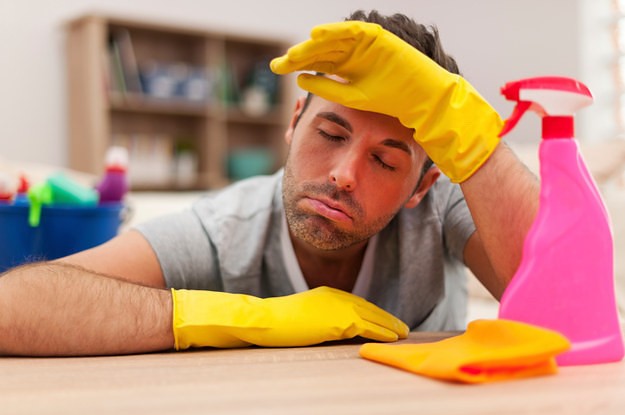
To finish the portrait
And finally, a few recommendations from ordinary housewives. All of them are found on specialized forums.
- “I enjoy cleaning when I have clean rags and sponges in my hands, good household chemicals. Therefore, I keep my instruments attractive. “
- “I bring the house to the state of a garbage dump (I don’t clean it for 1.5-2 months), then this mess gets me, and in a day I clean everything with great pleasure”.
- “The more energetic the music, the faster you get to clean your apartment. Fitness music helps a lot. And when I listen to audiobooks, in general, time flies by.
- “My advice is to get out as quickly as possible. Most of the time is spent on wiping small objects: figurines, caskets, and vases. I got rid of them all at once – I took them to my mother. “
- “Recently I noticed that if I get angry, I become like a bee: I clean everything quickly and efficiently”.
- “Perfectionism is our enemy. It took a lot of work on yourself so as not to feel like a lazy person when you do not wash the entire door, but only where it is dirty. “
- “I come up with a reward for my work. For example, I buy my favorite cake, which is prohibited the rest of the time. I cleaned the room and cut a piece. “
- “Life hack, how to force yourself to clean the apartment. When the house is a hell of a mess, I call guests. The meeting is scheduled, but there is nowhere to go – you have to restore order. “
- “I have a rule: to buy any new thing in the house, you need to throw out any old one”.
- “I once met a piece of advice:“ To make cleaning quick and interesting, introduce an element of the game. Do it with your husband, naked, in one apron. ”
